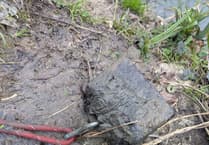Somerset can lay claim to one of the earliest photographs taken in England. While the names of Louis Daguerre and William Henry Fox Talbot are synonymous with the invention of photography about 180 years ago, it was a portrait painter and optician, Frederick Lake, of Bath Place, Taunton, who took what was probably the earliest image in Somerset.
This was a ‘daguerreotype’ of the tower of St Mary Magdalene, Taunton, reported in the Taunton Courier of 2nd October, 1839, as a “curiously faithful picture.” It isn’t known if this image has survived, and it seems unlikely. However, it may be that someone reading this article knows otherwise.
Frederick Lake is just one of nearly 800 photographers who are featured in a new book, Secure the Shadow: Somerset Photographers, 1839-1939 by local authors, Robin Ansell, Allan Collier and Phil Nichols.
The book is a celebration of Somerset’s photographic history, as seen through the lives of its photographers. It includes a listing of photographers, and the dates and locations of their studios – a key resource for estimating the date of photographs.
Somerset’s very first photographic studio is identified, this being opened in 1841 in the Royal Victoria Park, Bath. A disk containing nearly 4,500 pages accompanies the book, and this includes biographies of the photographers, based on census information, newspaper articles (more than 3,000), and on books, archive material, and many other sources.
The disk also includes selections of the photographs they took (more than 1,500) – ambrotypes, stereo views, cartes de visite, cabinet cards, tintypes, postcards etc.
Author, Robin Ansell, said: “With the large number of photographers whose lives and careers we’ve studied, there was always likely to be quite a range of characters. We’ve found one photographer who claimed to have saved Queen Victoria from assassination, another who died in a tragic accident by falling fifteen stories down a lift shaft in a Chicago skyscraper, several whose studios were blown away by gales, many who went bankrupt – with several being imprisoned for debt – and one who was imprisoned for stealing a military cornet, only to become the cornet-playing bandmaster of the Third Somerset Rifle Volunteers just three years later.
“We learned of the photographic career of the eminent inventor, John Stringfellow of Chard, who is said to have achieved the first powered flight in 1848; also of Will Jones (W. M. Jones), who was both the author of the Somerset dialect ‘Jarge Balsh’ books, and also a part-time photographer at Coleford. These are just a few of the many life stories we describe in the book.”
The book includes seven Midsomer Norton and Radstock photographers, plus others in nearby towns and villages, such as the Bath area, Chilcompton, Clutton, Coleford, Keynsham, Pensford and Shepton Mallet, and is available from publishers, the Somerset and Dorset Family History Society, online at: shop.sdfhs.org/publications/somerset-books




